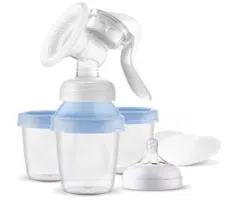Loading ...
Loading ...

English
Introduction
Congratulations on your purchase and welcome to Philips Avent! To
fully benet from the support that Philips Avent oers, register your
breast pump at www.philips.com/mybreastpump.
General description (Fig. 1)
1 Handle
2 Silicone diaphragm
3 Stem
4 Pump body
5 Cushion
6 Cushion cover
7 White valve
8 Philips Avent Natural bottle*
9 Bottle cap
10 Screw ring
11 Feeding nipple
12 Sealing disc
* For this accessory, a separate user manual is provided. Read the
separate user manual carefully, as it contains important safety
information.
Intended use
The Philips Avent manual breast pump is intended to express and
to collect milk from the breast of a lactating woman. The device is
intended for a single user.
IMPORTANT SAFETY
INSTRUCTIONS
Read this user manual carefully before you use the breast pump and
save it for future reference.
CONTRAINDICATION
- Never use the breast pump while you are pregnant, as
pumping can induce labor.
WARNINGS
Warnings to avoid choking, strangulation and injury:
- Do not allow children or pets to play with the breast pump
parts, packaging materials or accessories.
- Before each use, visually inspect the individual components for
cracks, chips, tears, discoloration or deterioration. In the event that
damage to the device is observed, discontinue use until the parts
have been replaced.
Warnings to avoid contamination and to ensure hygiene:
- For hygienic reasons, the breast pump is only intended for
repeated use by a single user.
- Clean and disinfect all parts before rst use and after each use.
- Do not use antibacterial or abrasive cleaning agents to clean the
breast pump parts as this may cause damage.
- Wash your hands thoroughly with soap and water before you
touch breast pump parts and breasts to prevent contamination.
Avoid touching the inside of containers or lids.
Warnings to avoid breast and nipple problems including pain:
- Always release the handle before you remove the pump body
from your breast in order to release the vacuum.
- If the vacuum is uncomfortable or causes pain, stop pumping and
remove the breast pump from your breast.
- Do not continue pumping for more than ve minutes at a time
if you do not succeed in expressing any milk. Try to express at
another time during the day.
- If the process becomes very uncomfortable or painful, stop using
the pump and consult your healthcare professional.
- Only use accessories and parts recommended by Philips Avent.
- No modication of the breast pump is allowed.
Warning: If you are infected with Human Immunodeciency Virus
(HIV) or Hepatitis B or C, using the breast pump will not reduce or
remove the risk of transmitting the virus to your baby through breast
milk.
CAUTIONS
Caution to prevent damage to and malfunctioning of the breast
pump:
- Keep the parts away from heated surfaces to avoid deformation of
these parts.
SAVE THESE INSTRUCTIONS
Preparing for use
Disassemble, clean and disinfect all parts before you use the breast
pump for the rst time and after every use.
Caution: Be careful when you remove and clean the white
valve. Do not insert objects into the white valve, as this may
cause damage.
Cleaning and disinfecting
Disinfecting is especially important if your baby is less than 3months
old, was born prematurely, or has a weakened immune system due
to illness or medical treatment. To ensure hygiene, perform the
disinfecting step at least once a day.
Step 1: Disassembling
Disassemble the breast pump and bottle completely. Also remove
the white valve from the pump body and the stem from the silicone
diaphragm.
Step 2: Cleaning
The parts can be cleaned manually or in the dishwasher.
Step 2A: Manual cleaning
Supplies needed:
- Mild dishwashing liquid
- Drinking-quality water
- Soft, clean brush used only
for infant feeding items
- Clean tea towel or drying
rack
- Clean bowl used only for
infant feeding items
1 Rinse all parts under a running tap with lukewarm water. Do not
place the parts in a sink to rinse.
2 Place all parts in a clean bowl.
3 Add warm water and some mild dishwashing liquid.
4 Clean all parts with a cleaning brush.
5 Thoroughly rinse all parts under a running tap with cold clear
water by holding them.
6 Clean the bowl and the brush. Rinse them well and allow them to
air-dry after each use. Wash them by hand or in a dishwasher at
least every few days.
7 Leave all parts to air-dry on a clean, unused tea towel or drying
rack in an area protected from dirt and dust. Do not use a tea
towel to rub or to pat the items dry.
Step 2B: Cleaning in the dishwasher
Supplies needed:
- Mild dishwashing liquid or a dishwashing tablet
- Drinking-quality water
Note: Food colorings may discolor parts.
1 Place all parts on the top rack of the dishwasher.
2 Put dishwashing liquid or a tablet in the machine. Run a standard
program using hot water and a heated drying cycle (or sanitizing
setting).
Loading ...
Loading ...
Loading ...
